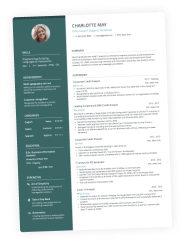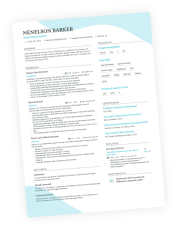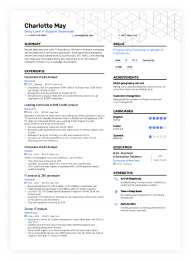Your online presence can make—or break—your job search. If your resume tells the story, your portfolio shows it. A clear, well-placed portfolio link lets hiring managers jump straight to your best work without asking for samples or scheduling extra calls.
In this guide, you’ll learn where to place your link for maximum visibility, how to write a compelling one-sentence description that earns the click, what to include (and remove) in your portfolio, and how to avoid the mistakes that quietly sink applications. You’ll also see role-specific examples and wording you can copy now.
Key takeaways
- Put your portfolio link in the header and repeat it once more, where it adds context (summary or relevant experience bullet).
- Use a concise description next to the link that signals relevance (e.g., “Case studies: UX flows, A/B results, accessibility fixes”).
- Keep only current, role-aligned work—prune anything outdated, redundant, or off-brand.
- Make the link short, branded, and 100% clickable on PDF and mobile.
- Add live demos or case studies with outcomes, not just screenshots.
- If you use a landing page, tailor it to the role you’re applying for—put your top three projects first. If your portfolio is small or focused, you can skip the landing page and lead directly to your strongest work.
- Test your link on multiple devices and readers before you send the resume.
Is your resume good enough?
Drop your resume here or choose a file. PDF & DOCX only. Max 2MB file size.
Importance of including a portfolio
Adding a portfolio link transforms your resume from claims into proof. For creative and technical roles alike—UI/UX designs, branding projects, digital illustrations, photography—hiring managers want to see how you think, what you shipped, and the impact.
Why a portfolio changes outcomes
- Shows the “how”: A resume lists responsibilities—a portfolio shows reasoning, iterations, and trade-offs—your craft and judgment.
- Demonstrates results: Case studies connect decisions to metrics (conversion, latency, engagement), turning work samples into evidence.
- Signals maturity: A structured portfolio section with a clear gallery and concise captions suggests strong communication and strategic vision.
- Accelerates screening: Reviewers can verify fit in one click, reducing back-and-forth for samples and speeding interviews.
- Supports ATS-era hiring: While applicant tracking systems (ATS) parse the resume, recruiters still click links—portfolios give depth that AI parsers can’t.
What it proves (beyond visuals)
- Leadership qualities: Mentoring juniors, running design crits, facilitating discovery—documented in case studies or project notes.
- Systems thinking: Style guides, component libraries, and scalable patterns for UI/UX designs and branding projects.
- Execution at speed: Staged deliverables (MVP → polish), on-time releases, pragmatic scope cuts.
- Cross-functional influence: Clear artifacts that help PMs/engineers ship—tickets, specs, prototypes.
Most people tuck their portfolio link at the bottom like an afterthought—that’s a mistake. If your work is your best argument, put it where recruiters can’t miss it: the header. Think of it less like “extra material” and more like your highlight reel. A weak portfolio hurts you more than no portfolio, so edit ruthlessly and link only to what you’re proud of.
Editor’s take
Role-specific value
- Design (UI/UX): Interactive flows, usability findings, accessibility work—pairing screens with measured outcomes beats static dribbles.
- Illustration & concept art: The jump from ideation to final digital illustrations shows range and consistency—style sheets reveal production readiness.
- 3D & motion: Animated sequences demonstrate topology quality, rigging, lighting, and rendering choices better than stills.
- Photography: A curated photography section with themes and client notes communicates taste, reliability, and production workflow.
- Marketing/content: A/B results and funnel lift tie words and visuals to business goals—proof that narrative moves metrics.
- Engineering/product: Live demos, repos, and performance charts do what bullet points can’t—instantiate claims.
How portfolios help you tailor quickly
- Reorder selected works to mirror a job’s problems (e.g., onboarding, checkout, growth).
- Use project thumbnails that reflect the industry—swap them to match fintech, SaaS, or e-commerce roles.
- Add a short “Highlights for [Company]” panel linking the two most relevant projects with a one-sentence reason.
Where resume AI tools fit
- Use resume AI tools (like Enhancv’s) to generate tight, role-matched descriptions near your link: “Portfolio | case studies on forms, checkout, and error handling; +19–31% CVR.”
- Keep the heavy lifting (storytelling, ethics, redaction) human-led—AI assists with phrasing, ordering, and consistency.
What recruiters look for at a glance
- Clarity: Does the landing page summarize focus and outcomes in <10 seconds?
- Relevance: Are the first three projects aligned to the job?
- Quality: Are assets sharp, fast, and accessible on mobile?
- Credibility: Are outcomes specific and attributable?
- Professionalism: Is contact obvious, and is your resume downloadable?
Bottom line: A portfolio is the fastest path to trust. It shows your craft, your outcomes, and your ability to communicate—three signals that consistently separate interviews from pass-overs.
Now that you know why a portfolio can elevate your application, the next step is figuring out when it actually makes sense to include one on your resume.
Resumes vs. portfolios
A resume is a curated snapshot—one page that highlights your skills, experience, and achievements in a structured, scannable format. A portfolio, on the other hand, is a deeper dive: it shows proof of your work through projects, case studies, visuals, or demos.
Think of the resume as your invitation to the conversation, and the portfolio as the evidence that backs it up. Both should complement each other: the resume drives attention—the portfolio seals the deal.
When to include a portfolio on your resume
A portfolio isn’t always necessary, but in the right context, it can be the difference between getting noticed and getting ignored. Knowing when to include it—and when to leave it out—helps you present the strongest, most relevant version of your resume for each application.
Include a portfolio link when:
- The role asks for work samples, a book, reels, case studies, or GitHub.
- Your work is inherently visual, interactive, or demonstrable (design, dev, writing, analytics, marketing, research, product).
- You’ve completed projects that showcase the exact skills the job description emphasizes.
- You’re switching fields and need project evidence to bridge the gap between old and new experiences.
Skip or de-emphasize it when:
- The role is strictly regulated and samples can't be shared (e.g., confidential legal memos), and you don’t have permission to redact or anonymize.
- Your current portfolio is unfinished or misaligned—in that case, remove weak samples, add one strong case study, and then link.
Common pitfall: listing a portfolio without proof. If the work isn’t relevant, current, or accessible, the link hurts more than it helps.
Once you’ve decided a portfolio belongs on your resume, the next question is placement—because even the strongest link won’t help if recruiters never see it.
Where to place your portfolio link for maximum visibility
Recruiters spend seconds scanning resumes, so strategic placement can be the difference between a quick click and being overlooked.
Header (primary placement)
Put your short, branded URL beside your email and LinkedIn:
Yourname.com | linkedin.com/in/yourname | yourname@email.com
Make it clickable in your PDF. Most ATS recognize hyperlinks and many recruiters read PDFs on phones—tap-to-open matters.
Summary (contextual placement)
Add a one-line descriptor that primes the click:
“Portfolio: case studies on onboarding UX, forms accessibility, and B2C checkout uplift.”
Optimize your resume summary and objective for ATS
Drop your resume here or choose a file.
PDF & DOCX only. Max 2MB file size.
Experience section bullets (proof placement)
After a quantified achievement, drop a link to the specific case study:
“Improved funnel CVR +19% by redesigning account creation (see three-step flow case study).”
Skills or Projects section (secondary placement)
If you have a Projects section, make the project title a link. In a Skills section for devs, link “Open-source” or “Live demo” to a repo or sandbox.
PRO TIP
Avoid vague terms like “Website.” Use “Portfolio,” “Case studies,” “Film reel,” “Live demos,” or “GitHub” so a reader knows what they’re opening.
Of course, placement gets eyes on your link, but it’s the description beside it that convinces recruiters to click.
How to write a compelling portfolio link description
Your description is a mini-pitch. It should tell the reader what they’ll see and why it’s relevant—without fluff. On a resume, keep it to one line that highlights context or results. If the link is self-explanatory (e.g., “johndenver.dev”), you can skip the description, but for most projects, a short line makes the click more compelling.
Use the “What + Proof + Relevance” formula (10–14 words):
- “Case studies: mobile onboarding, payments UX; +19–31% conversion gains.”
- “Writing clips: long-form explainers, UX microcopy, email tests (CTR +22%).”
- “Live demos: React dashboards, Node APIs, automated tests; 85% coverage.”
Or, keep the header link ultra-short (three to seven words), then expand with this formula in the summary.
Avoid: Jargon with no outcomes (“agile polymath”), tool lists with no context (“Figma, Jira, Notion”), or generic claims (“creative problem solver”).
Make it role-specific: Mirror keywords from the job post so your description feels tailored: mention the product area, audience, platform, or metric the team cares about.
A well-written description will spark curiosity—but it only works if the portfolio behind the link is worth exploring. This means building a digital portfolio that’s refined and relevant.
Right vs. wrong: portfolio link wording on a resume
Even small wording choices can shape how professional—or forgettable—your portfolio link looks. A vague or generic label can get ignored, while a clear, outcome-focused line makes hiring managers want to click.
Let’s look at the right and wrong ways to word it.
Wrong (vague, no context)
Portfolio: www.johndesigns.com
Why it fails: No signal of content, outcomes, or relevance. It forces extra clicks and guesswork.
Right (specific, outcome-oriented)
Portfolio — Mobile fintech UX: KYC flow, error states, and onboarding (+23% pass rate)
Why it works: Describes scope, domain, and measurable impact. It tells a reviewer exactly what to expect.
Examples of effective portfolio links by role
Below are clean, Chicago-style, sentence-cased examples you can adapt. Each example includes a placement suggestion and a brief descriptor.
1. Graphic designer (branding + product)
Header: emmapetrova.com/brand
Summary: “Portfolio: identity systems, product illustrations, and packaging specs for DTC brands.”
Experience bullet: “Built modular identity for three SKUs, reducing packaging costs 12% (see dielines).”
2. Content writer (B2B + product education)
Header: stevewrites.com/clips
Summary: “Writing samples: product explainers, onboarding emails (CTR +22%), and UX microcopy.”
Experience bullet: “Launched knowledge base; deflected ~18% of tickets within 90 days (KB outline).”
3. Full-stack developer (React/Node)
Header: bobcodes.dev/demos
Summary: “Live demos: dashboard app (WebSocket streaming), auth-ready Node API, Cypress tests.”
Experience bullet: “Cut query latency 40% with indexed views and pagination (repo + demo).”
4. Photographer (portrait + landscape)
Header: emmaphoto.io/selected
Summary: “Online gallery: editorial portrait sets and long-form travel series curated by theme.”
Experience bullet: “Produced portrait series on location; six-page magazine spread (gallery + BTS).”
5. Marketing specialist (case studies)
Header: lindamarketing.co/cases
Summary: “Case studies: lifecycle automation, paid social, and landing page experiments.”
Experience bullet: “Increased free-to-paid +11% via onboarding sequence (see experiment plan).”
Seeing the difference between weak and strong wording is helpful, but having ready-to-use templates makes it even easier to craft the perfect portfolio link description.
How to craft the perfect portfolio link description (with templates)
Use these copy-and-paste lines, then tweak keywords to match a posting:
- Design: “Case studies: onboarding, accessibility (+19–31% CVR)”
- Writing: “Clips: product explainers & UX copy”
- Dev: “Live demos & repos (React, Node)”
- Marketing: “Campaign case studies: social & CRO”
- Research: “Studies: usability, surveys, mapping”
PRO TIP
If your portfolio covers multiple disciplines, create targeted landing pages and link the one that matches the job (e.g., “yourname.com/ux vs. yourname.com/content”).
Where each section of your resume can reference the portfolio
Every section of your resume offers an opportunity to point toward your portfolio—if you know how to do it without cluttering the page.
Header: primary link.
Summary: One-sentence description + link (tailored to the job).
Experience bullets: Link to the specific case study that proves the claim.
Projects section: Each project title is a link—add one impact metric.
Skills section: For hard skills, add an example link (“React (dashboard demo)”).
Education/certifications: Link to capstone or certification project if relevant to the role.
Example (experience bullet before/after)
Weak:
“Redesigned onboarding flow.”
Stronger:
“Redesigned onboarding flow; reduced time-to-value from 6m → 3m (case study).”
Referencing your portfolio throughout your resume is powerful—but it only works if the portfolio itself is well-built. That’s why getting the digital setup right matters just as much.
PRO TIP
A digital portfolio doesn’t need fancy tech—just clarity and consistency. Pick a stable platform (WordPress, Webflow, Notion, GitHub Pages), organize projects by outcomes not artifacts, and make each case study scannable: context, your role, key decisions, and results. Add only the visuals that matter, and set a quick monthly review to keep it fresh.
Showcasing skills and achievements through your portfolio
A resume claims—a portfolio demonstrates.
For every high-stakes claim on your resume, link a proof point:
- Designers: Before/after comparisons with measurable deltas (task success rate, completion time).
- Writers: A/B test results, readability improvements, style guides.
- Developers: Benchmarks, load tests, CI badges, coverage reports.
- Marketers: KPI ladders (impressions → clicks → signups → revenue) with controlled tests.
- Researchers: Study plans, artifacts, and synthesis outputs (redacted) with insights adopted by the team.
Add a “metrics” callout in each case study so reviewers can find the outcomes at one glance.
Even with a polished portfolio, many candidates still trip over the same avoidable missteps—so it pays to know the common questions and mistakes before you hit send.
Common questions and mistakes (and how to avoid them)
| Questions and mistakes | Answers |
|---|---|
| Will a portfolio make my resume too long? | No—your resume stays one to two pages. The portfolio offloads depth into linked pages. Keep descriptors short and targeted. |
| Can I link my homepage? | You can, but linking directly to a relevant landing page (e.g., case studies, reel, demos) reduces friction and increases engagement. |
| What if everything I’ve done is under the NDA? | Anonymize and abstract: describe the problem, constraints, and outcomes without naming the client. Recreate UI with dummy data; blur sensitive data; focus on decisions and impact. |
| Should I put my resume on my portfolio? | Yes. Add a downloadable PDF and a short bio. Some reviewers will find your portfolio first and look for your resume next. |
| How many projects are enough? | Three to six strong, role-aligned projects beat ten mixed-quality ones. Depth beats breadth. |
| Is GitHub alone a portfolio? | Repos help, but reviewers want context. Pair live demos and READMEs with problem statements and results. |
Top mistakes to fix now: broken links, slow load times, generic descriptors, wall-to-wall screenshots with no context, and outdated work that dilutes the signal.
PRO TIP
Struggling to write powerful resume bullets? Try Enhancv’s free Resume Bullet Point Generator and turn your achievements into impact-driven statements in seconds.
Right vs. wrong: linking from experience bullets
Experience bullets are prime real estate on your resume, but too many candidates waste them with vague links or cluttered wording. Done right, a portfolio link here can transform a claim into instant proof—done wrong, it just distracts or confuses.
Wrong
“Led user research. Portfolio: mysite.com/research.”
Issue: Generic and unhelpful.
Right
“Interviewed 18 SMB owners; synthesized 5 opportunity areas adopted in roadmap (study summary).”
Win: Specific scope, sample size, adoption signal, and a link to the exact artifact/anchor text.
Strong experience bullets set the standard—but what counts as ‘good’ will look different depending on your career stage, whether you’re a student, intern, or junior.
Student, intern, and junior progression: what “good” looks like
A portfolio grows with you, and what feels impressive at the junior level isn’t the same as what hiring managers expect from a mid-level or senior. For students, interns, and juniors, the goal is to show potential, growth, and readiness—without pretending you already have years of experience.
Students
- Built a course project site with accessibility basics (semantic HTML, labels, focus states).
- Analyzed survey data in Google Sheets; presented insights with clear charts and takeaways.
- Wrote a short case study on iteration from critique to final deliverable, with what changed and why.
- Contributed a small PR to an open-source component, including tests and documentation.
Interns
- Delivered a scoped improvement (e.g., empty states, loading skeletons) and documented impact.
- Shipped a content experiment (subject lines, landing copy) and reported CTR/CR.
- Supported moderated usability with note-taking and synthesized 3 key insights.
- Automated a repetitive task and reduced manual time by 30%.
Juniors
- Owned a small but complete feature from brief to release; documented constraints and trade-offs.
- Connected metrics to outcomes (e.g., “first contentful paint improved 22%”).
- Added tests or documentation that improved team velocity.
- Created a clean, navigable portfolio section with two strong case studies.
For mid-level and leads: Emphasize cross-functional influence, strategy, and repeatable framework. Include artifacts such as design principles, playbooks, or experiment roadmaps.
How to tailor your portfolio to each application (in minutes)
One portfolio won’t fit every job. The fastest way to stand out is to tailor your portfolio so the first thing a recruiter sees matches exactly what they’re hiring for—and the good news is, it only takes a few minutes.
- Re-order projects so the most relevant three appear first.
- Mirror job language in your case-study intros and your link description.
- Swap thumbnails to show the product area (mobile, checkout, dashboard) that a team cares about.
- Add a one-page “Highlights for [Company]” linking the top two case studies with a sentence on why each matters to their goals.
Troubleshooting: What to do if your portfolio isn’t getting clicks
- Shorten and clarify your descriptor (“Case studies: checkout, pricing, onboarding (+11–23% CVR)”).
- Move the link to the header and repeat it once in the summary.
- Link directly to the relevant case study from a matching bullet.
- Replace the first project with the one that best mirrors the job description.
- Speed up the landing page—if it’s slow on a phone, fix that first.
- Ask a peer to review for clarity and skim-ability—rewrite dense sections.
Frequently asked questions: portfolios on resumes
Even with all the best practices in place, candidates still have lingering questions about portfolios—when to add them, how much to include, and whether they can ever replace a resume. This FAQ clears up the most common concerns.
Should I use one portfolio for all roles?
Keep one master portfolio, then maintain role-specific landing pages (e.g., /ux, /content, /growth) and link the most relevant one per application.
How long should a case study be?
Long enough to show context, decisions, and results—usually three to six concise sections with scannable headings and images. If it takes more than five minutes to grasp, tighten it.
Can I show drafts and failures?
Yes—briefly. Show the path, what didn’t work, and how you corrected course. Keep the focus on decisions and learning.
What if I don’t have strong metrics?
Not every portfolio needs hard numbers—especially in industries where impact isn’t measured in conversion rates or revenue. If you can’t show metrics, use proxy indicators like support tickets deflected, task success in usability tests, or stakeholder adoption.
You can also add qualitative proof, such as short quotes from users, managers, or peers (clearly attributed). The key is to show evidence of value, whether through numbers, outcomes, or trusted feedback.
Is a Notion or Google Drive portfolio acceptable?
For an early career, yes, if organized and public. For mid-senior and client-facing roles, a branded site signals polish and reliability.
Do I need a custom domain?
It helps with memorability and trust. If timing is tight, ship the work first on stable hosting, then migrate to a custom domain later.
Conclusion
A clear, role-aligned portfolio link turns your resume from claims into proof. Place it in your header, echo it once where it adds context, and send reviewers to a landing page that leads with the three most relevant projects, crisp visuals, and measurable outcomes. Keep it fast, accessible, and pruned—depth where it matters, brevity everywhere else.
Ready to build a resume that integrates your portfolio beautifully? Try Enhancv’s free AI Resume Builder to generate polished, ATS-optimized sections and place your portfolio link exactly where recruiters expect it. Create your resume in minutes and let your best work do the talking.
Make one that's truly you.



